Looks like LinkedIn is the place to be? At least for me, right now, see you there & happy to connect 👋
(tried X, BlueSky, and Mastodon)
16.09.2025 18:04 — 👍 2 🔁 0 💬 0 📌 0
"Who Thrives and Who Falls Behind? Household Income Differences in Luxembourg and its Neighbouring Countries"
... and why we need more research on Luxembourg✍️☺️
www.lisdatacenter.org/newsletter/n...
16.09.2025 07:14 — 👍 2 🔁 1 💬 0 📌 0

New Capitalism in America
Richest capitalists and richest workers are increasingly the same people
My today's Substack:
New Capitalism in America
Richest capitalists and richest workers are increasingly the same people
branko2f7.substack.com/p/new-capita...
24.07.2025 06:02 — 👍 15 🔁 6 💬 1 📌 7
seems like a built in feature to keep AI human like.
23.07.2025 22:03 — 👍 0 🔁 0 💬 0 📌 0

How does housing affect living standards in the UK?
Our new interactive charts allow you to explore the status of affordability, supply and quality of British housing ⤵️ buff.ly/X5xMmnF
22.07.2025 13:38 — 👍 4 🔁 5 💬 0 📌 0
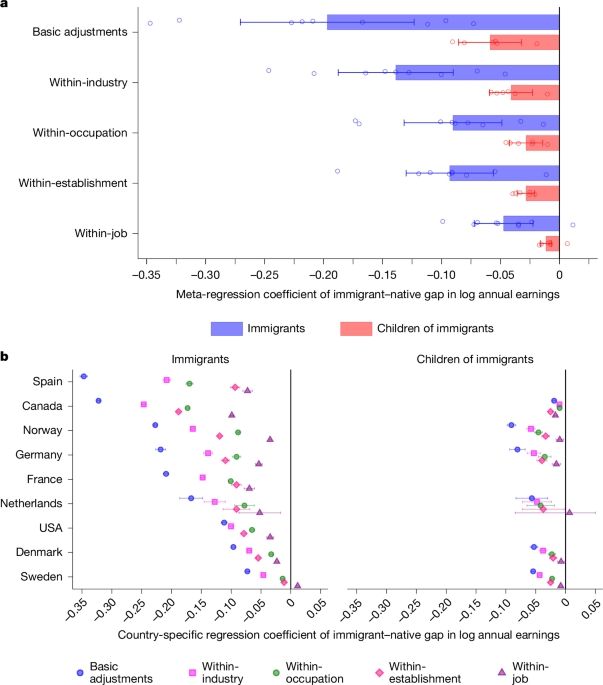
Immigrant–native pay gap driven by lack of access to high-paying jobs - Nature
Data from nine European and North American countries reveal that the disparity in earnings between immigrants and natives is largely a result of segregation of immigrant workers into lower-paying jobs...
IN OTHER NEWS: check out our new COIN paper on immigrant--native pay gaps in advanced economies published in @nature.com this afternoon! Specifically, we study the relative contribution of within-job unequal pay vs between-job segregation to earnings disparities across immigrant generations. 1/9
16.07.2025 15:16 — 👍 65 🔁 28 💬 4 📌 2
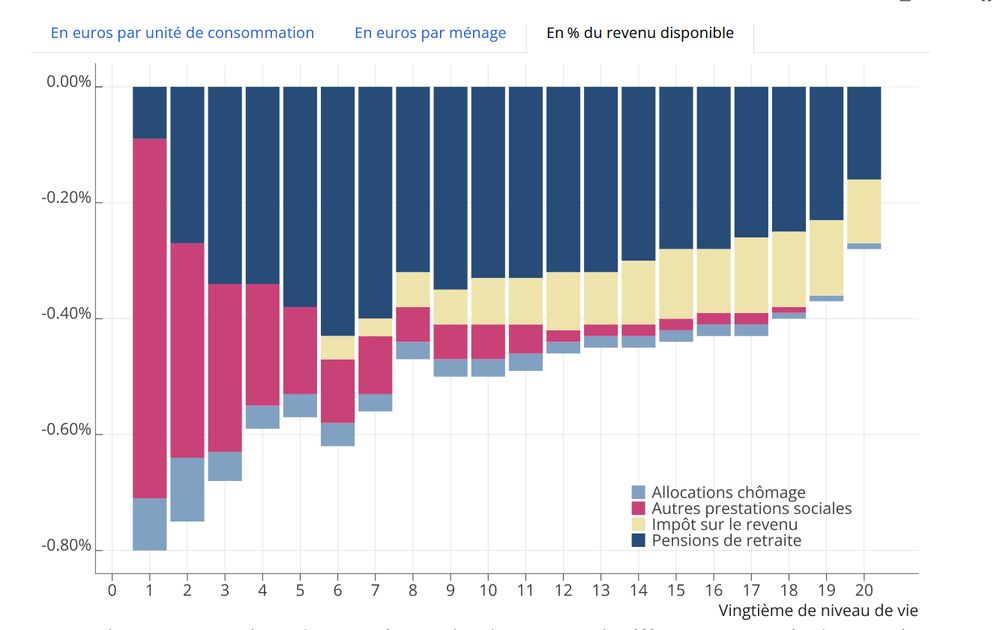
Effet du gel des prestations sociales, des pensions de retraite et de l'IR par 20e de niveau de vie.
Le niveau de vie est diminuée d'environ 0,8% au 1er vingtième, 0,6% au 6e vingtième et 0,4% au delà de la médiane
Impôts et prestations: quels effets attendre d’une « année blanche »? Par @pmadec.bsky.social
% au revenu, l'effet d'un gel est bien évidemment plus fort sur les ménages modestes (via les prestations) que sur un ménage médian (via l'IR)
www.ofce.sciences-po.fr/blog2024/fr/...
15.07.2025 16:39 — 👍 517 🔁 361 💬 13 📌 17

Chart showing Proportion of non-pensioner households’ non-housing consumption on ‘essentials’, by equivalised after-housing-costs household income quintile: UK
The bottom two-fifths of the income distribution saw the biggest rise in essentials spending between the financial crisis and the pandemic
Rising energy prices in particular have led to a ‘comfort crunch’ as families spend more of their budgets on essentials.
11.07.2025 15:35 — 👍 5 🔁 3 💬 0 📌 1
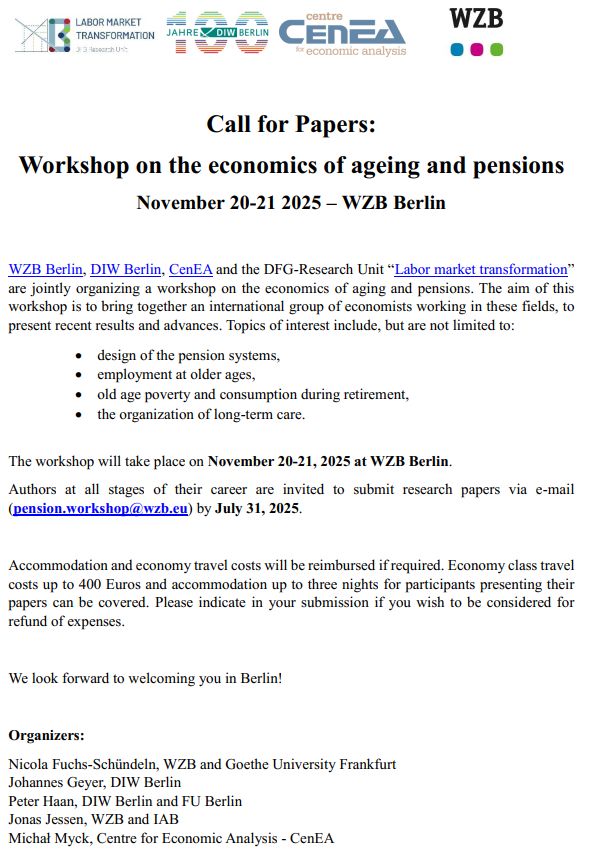
📣CALL FOR PAPERS 📣
Workshop on the economics of ageing and pensions
tinyurl.com/2wez4wp7
Where? Berlin @wzb.bsky.social 🐻
When? November 20-21 November 🍂
For whom? Researchers at all stages in their career
Anything else? Accomodation & travel cost will be covered 🚅🏨
Please circulate!
26.05.2025 09:26 — 👍 46 🔁 37 💬 1 📌 4

The divergence in child versus pensioner income trends over both halves of the 2020s is also not new. In 2002-03 pensioners and children had very similar typical equivalised household incomes, but between then and 2023-24 the median pensioner income grew by 32 per cent and the child figure by 7 per cent (with the typical working-age income growing by 8 per cent). In cash terms, the equivalised household income gap between pensioners and children has grown from roughly zero in the early 2000s to over £5,000 by 2023-24 and potentially over £7,000 by 2029-30. As we explore below, this is also reflected in poverty figures.
The typical pensioner and typical child’s household income were once very similar, but have diverged.
In cash terms, the equivalised household income gap between pensioners and children has grown from roughly zero in the early 2000s to over £5,000 by 2023-24 and potentially over £7,000 by 2029-30.
10.07.2025 11:24 — 👍 9 🔁 4 💬 1 📌 1
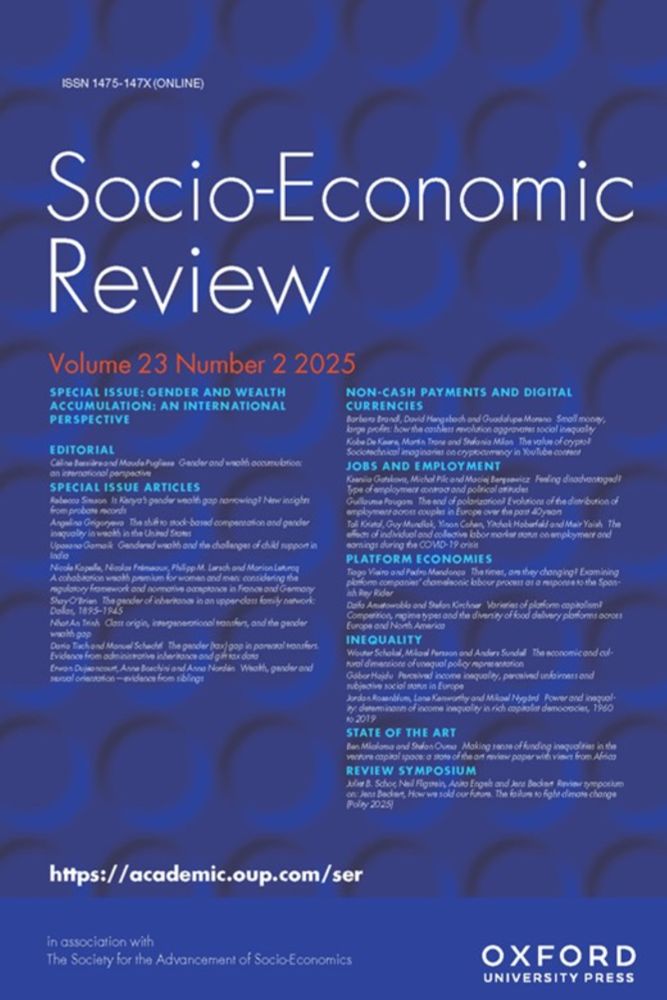
Gender and wealth accumulation: an international perspective
Abstract. Why do women accumulate less wealth than men globally? As wealth inequality rises both within countries and worldwide, studies on gender and weal
1/10 🚨Why do women accumulate less wealth than men across countries and time?
I had the privilege of co-directing the latest Special Issue of #SER @sasemeeting.bsky.social with @celinebessiere.bsky.social on gender and wealth accumulation. 🧵 ⤵️
academic.oup.com/ser/article/...
09.07.2025 15:58 — 👍 48 🔁 21 💬 2 📌 1
Comparable, well, so so... yes, the Americans can in principle buy more, but in fact they may need to spend more for private healthcare, education, and childcare, which is typically integrated in public services in Denmark.
09.07.2025 15:44 — 👍 2 🔁 0 💬 0 📌 0


It remains remarkable to look at PPP-adjusted amounts. The Danish look less well off, and the distance between lone parent and couple households in the U.S. is much higher.
09.07.2025 15:44 — 👍 1 🔁 0 💬 1 📌 0

The similar pattern can be observed in the U.S. However, there, particularly single parent households lose after receiving additional support during the COVID years.
09.07.2025 15:44 — 👍 1 🔁 0 💬 1 📌 0

Interesting insights in the inflation crisis with latest #LISdata
Danish incomes in real terms decreased massively in 2022 for all household types.
09.07.2025 15:44 — 👍 1 🔁 1 💬 1 📌 0

Chart showing Proportion of non-pensioner households’ non-housing consumption on ‘essentials’, by equivalised after-housing-costs household income quintile: UK
The bottom two-fifths of the income distribution saw the biggest rise in essentials spending between the financial crisis and the pandemic
Rising energy prices in particular have led to a ‘comfort crunch’ as families spend more of their budgets on essentials.
07.07.2025 14:40 — 👍 5 🔁 6 💬 0 📌 0

Poorer families in Britain are spending more of their income on essentials
The poorest half of working-age households now spend 49% of their non-housing budgets on essentials like food, utility bills, clothing, childcare, and transport, up from 42% in 2002.
Meanwhile richer households now spend 41% of their budgets on essentials, up from 37% in 2002.
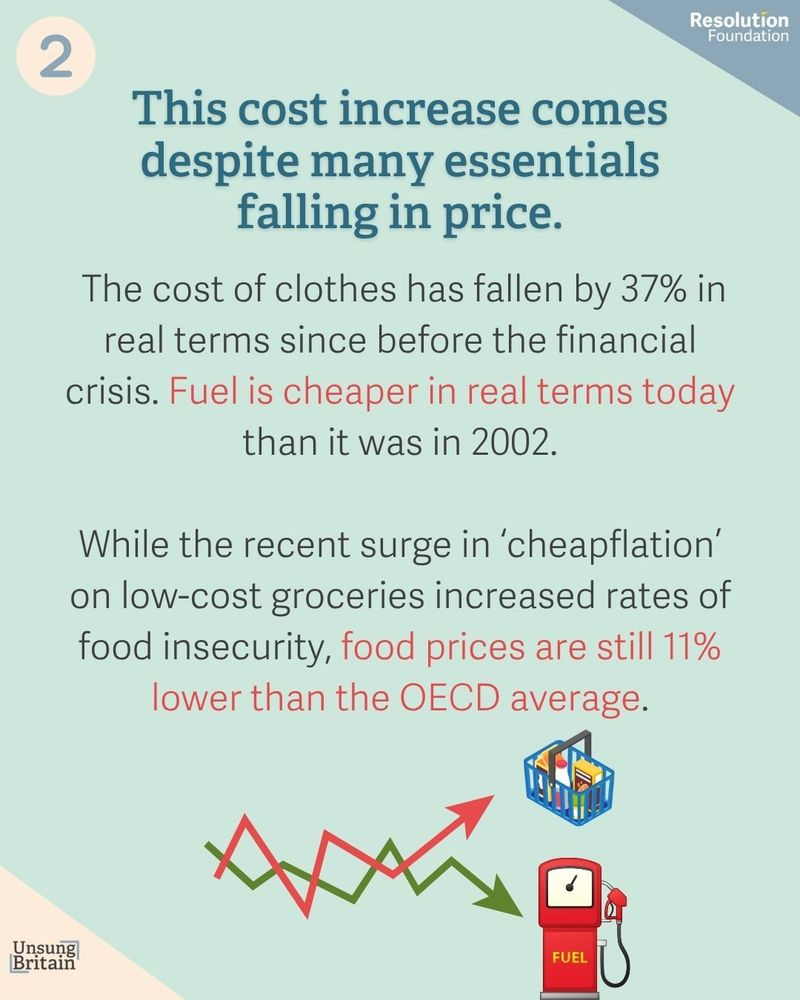
This cost increase comes despite many essentials falling in price.
The cost of clothes has fallen by 37% in real terms since before the financial crisis. Fuel is cheaper in real terms today than it was in 2002.
While the recent surge in ‘cheapflation’ on low-cost groceries increased rates of food insecurity, food prices are still 11% lower than the OECD average.
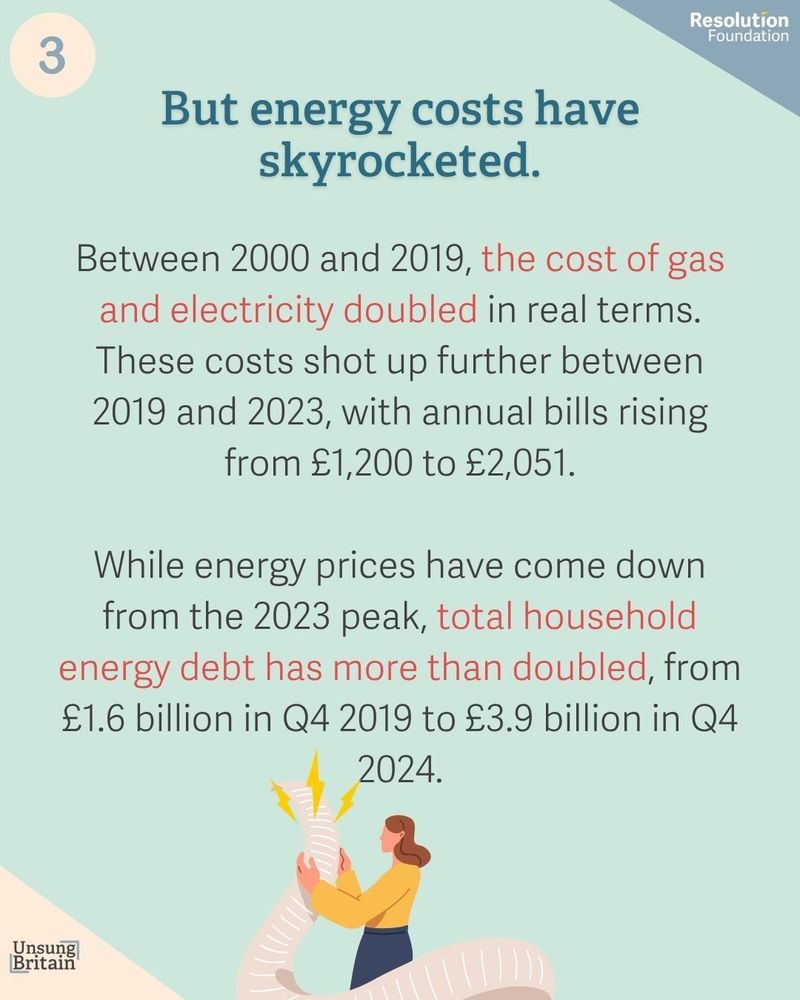
But energy costs have skyrocketed.
Between 2000 and 2019, the cost of gas and electricity doubled in real terms. These costs shot up further between 2019 and 2023, with annual bills rising from £1,200 to £2,051.
While energy prices have come down from the 2023 peak, total household energy debt has more than doubled, from £1.6 billion in Q4 2019 to £3.9 billion in Q4 2024.

A social tariff could help struggling families with energy bills.
Offering a 10% tariff discount to the poorest two-fifths of households in England and Wales would cost £1.6 billion.
This the same as the expected cost of the re-introduce Winter Fuel Payments, but better targeted at those who need help the most.
Low-to-middle income families have been experiencing a 'comfort crunch', as they now spend more of their budgets on essentials, especially energy and food.
Read more 👉 buff.ly/gXWlEGQ
07.07.2025 15:43 — 👍 18 🔁 6 💬 1 📌 1
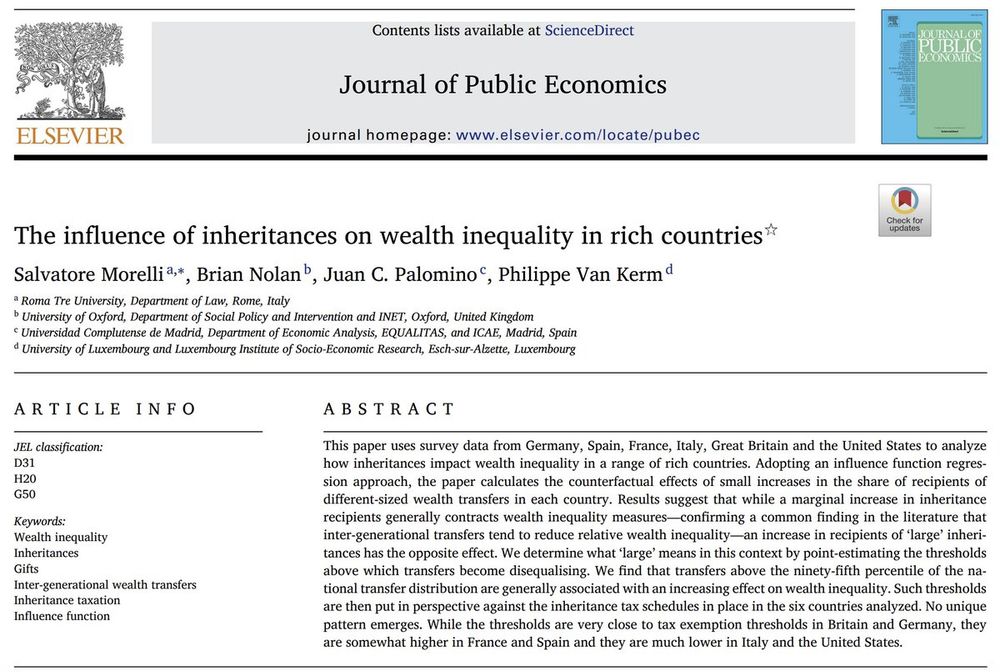
Just published in @jpube.bsky.social:
"The Influence of Inheritances on Wealth Inequality in Rich Countries"
By @morellisal.bsky.social, Brian Nolan, @juancpal.bsky.social, & Philippe Van Kerm
www.sciencedirect.com/science/arti...
#econsky #publiceconomics #publicfinance
29.06.2025 16:05 — 👍 62 🔁 22 💬 3 📌 1
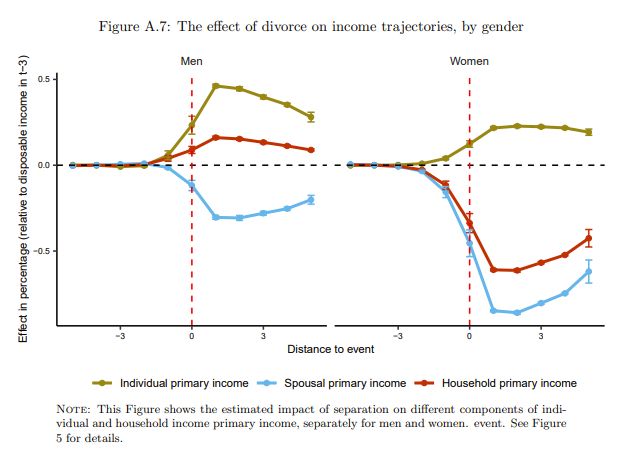
Very striking findings on the effect of divorce for men vs. women from a recent study, underlying data are administrative data from the Netherlands
www.cpb.nl/sites/defaul...
02.07.2025 18:31 — 👍 1 🔁 0 💬 0 📌 0
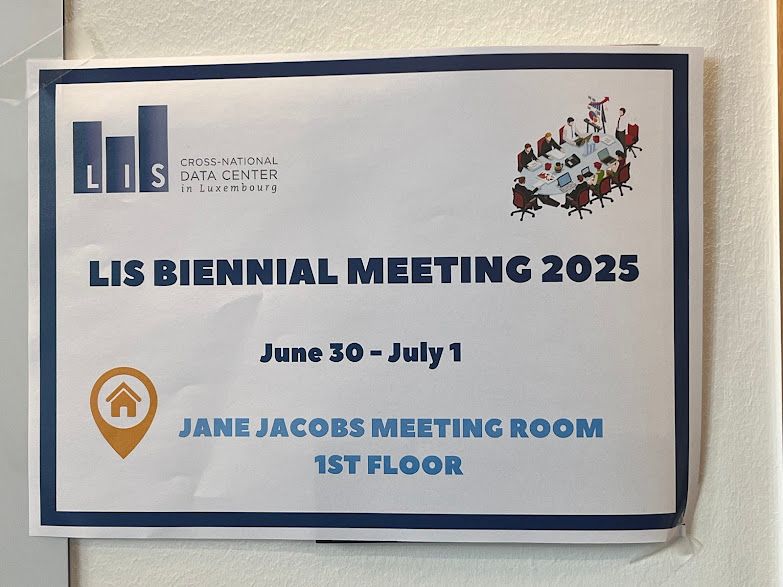

It's a wrap! The 2025 meeting of LIS' governing body, where representatives from many countries assess past work, review current projects, and plan LIS' future. These meetings demonstrate the extraordinary power and potential of international cooperation. #42years @lisdata.bsky.social
01.07.2025 12:20 — 👍 8 🔁 2 💬 1 📌 0
Second, private pensions became more equally distributed among the retired in most countries." [3/3]
19.06.2025 06:19 — 👍 0 🔁 0 💬 0 📌 0
First, more equally distributed public pensions in emergent multi-pillar systems and declining shares of capital income in mature multi-pillar systems either fully or partially compensated for increased inequality due to larger shares of private pensions. [2/3]
19.06.2025 06:19 — 👍 0 🔁 0 💬 1 📌 0
"Higher shares of private pensions in retirement incomes have a substantial inequality-increasing effect; yet, overall income inequality among the retired has not necessarily increased, for 2 reasons. [1/3]
19.06.2025 06:19 — 👍 0 🔁 0 💬 1 📌 0
'Changes in Private Pensions and Income Inequality in Retirement: A Decomposition Analysis by Income Source in Nine European Countries (1986–2018)'
by Laure Doctrinal (2023)
academic.oup.com/workar/artic...
19.06.2025 06:19 — 👍 1 🔁 0 💬 1 📌 0

DIW Berlin: Researcher (f/m/x)
We are hiring a 3-year postdoc for the ERC-funded WEALTHTRAJECT project at DIW Berlin. More details here: www.diw.de/sixcms/detai...
13.06.2025 13:51 — 👍 43 🔁 40 💬 0 📌 1
"Despite large increases in state pension incomes for women born since 1950 (and higher average household incomes among pensioners), these changes have not led to large falls in relative income poverty for these women compared with previous generations at the same age" [UK]
17.06.2025 06:40 — 👍 0 🔁 0 💬 0 📌 0
Postdoc in Economics at Jönköping International Business School. Interested in pensions, gender inequality, financial literacy and experiments. she/her.
https://sites.google.com/view/janaschuetz
professor of sociology at the University of Oslo. trying to explain why some do, and some don't. "well, I can tell you about the river / or we could just get in"
Postdoc at WZB and IAB.
Interested in everything losely related to labour economics.
But also here for fun!
https://sites.google.com/view/jesseneconomist
Assistant Professor of Sociology, University of Michigan. Studying cities and inequality
SHARE is a research infrastructure for studying the effects of health, social, economic and environmental policies over the life-course of European citizens and beyond.
Database management @share-eric.bsky.social
PostDoc @ SHARE Berlin Institute
Research interests: inequalities in health & health behaviours, (measurement of) physical activity
Associate professor, Lund University, Sweden. Research on trust, welfare states, health and migration.
Poverty scholar at heart and applied economist by training. Associate professor @univgirona.bsky.social. I like the fresh air from the mountains (#berguedà). Half the heart in the North.
www.saraayllon.eu
Economista. Income & wealth #inequality #research @KOFETH @ETH | Affiliated @cepr_org @CESifoNetwork @WIL_inequality @HSGStGallen
#EconSky
www.isabelzmartinez.com
Nature-loving sociologist at gesis.org.
Social stratification, education & skills, migration & integration, measurement of social structure. ISCED specialist, research infrastructure enthusiast.
Mother of 2, free-time gardener, believer in small changes.
Associate Professor of Public Policy @fordschool @umich. Social demographer studying children and families, poverty, and social policy. Mitad Española. She/her.
I study power, politics, and inequality. Currently focusing on class inequality as a function of business & finance power.
CUNY Graduate Center Sociology PhD student, teaching @ Brooklyn College. 🌹, 🏳️🌈, etc.
StoneCenter.gc.cuny.edu/people/murphy-robert/
Sociology Prof @ Upenn. Feminist studying gender, families, inequality, and social policy. She/her. The nuclear family is radioactive ⚠️⚠️
Postdoctoral researcher - Scuola Superiore Sant’Anna (Pisa)
Inequality • Climate Change • Taxation
Website: https://sites.google.com/view/elisa-palagi
Sociology, demography and gerontology @univie.ac.at
#grandparents #ageing #IntergenerationalRelationships
Team: @ageingsocvienna.bsky.social
We are the EU network of family organisations advocating for strong social policies for ALL #families. #disability #genderequality #saferinternet
Postdoctoral researcher at the @dspi-oxford.bsky.social focusing on families, division of care labour and comparative social policy. Previously at UCL’s TCRU & LISER in Luxembourg
Hope machine ☀️ all things 📚, 🎾 and 🏄🏻♀️
Social stratification and socioeconomic inequality. Lover of yacht rock, disco and parsimonious OLS equations - ideally all at the same time.
Development microeconomist, mostly labour. Research Fellow @dpru-uct.bsky.social, UCT 🇿🇦 • Visiting Scholar @unu-wider.bsky.social 🇫🇮 • Consultant, World Bank • Research Associate, RESEP, Stellenbosch University • PhD, UCT
https://timothykohler.github.io
























